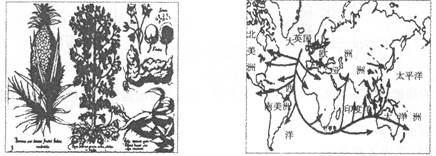(12分)阅读材料,完成下列要求。

14世纪欧洲人对遥远国度的想象 通过十字标尺测量,航海者可以确定维度
图1 图2

美洲一些植物,被欧洲人所熟悉 19世纪后期英国海外贸易示意图
图3 图4
结合所学知识,概述以上图片所反映史实间的内在联系。(12分)(要求:逻辑严密,语言流畅、表达清晰。)
标准l:能在图1、2、3、4之间建立关联,并能从中看到深层次的社会历史因素。(9~12分)
标准2:能在图1、2、3、4之间建立关联,但仅能描述历史现象。(5~8分)
标准3:只能在部分图片之间展开讨论或罗列史实。(0~4分)
示例1:14世纪处于新航路开辟之前,当时欧洲人对遥远国度的这种想象反映了世界各地处于相对孤立状态,各文明之间很少交流,彼此之间并不了解。随着西欧生产力的发展,科学技术的进步,欧洲人拥有了在各种复杂气候条件下进行远航的能力,新航路开辟与早期殖民扩张打破了世界彼此孤立的状态。地理大发现促进了物种的交流,地区性贸易开始向世界性贸易扩展,贸易数量和贸易品种增加,世界市场的雏形开始出现。欧洲贸易中心由地中海转移到大西洋沿岸,直接刺激了英国资产阶级的成长,为英国的资产阶级革命和工业革命奠定了基础。19世纪中后期,一个以欧美资本主义国家为主导的世界市场基本形成,最发达的资本主义国家英国是世界贸易中心。总之,随着经济与科技的发展,人类从各民族分散孤立地发展走向整体世界,也使人们的生活和思想观念发生巨大变化。
示例2:14世纪,随着欧洲资本主义萌芽的产生及对黄金等贵重金属的渴求,激发了欧洲人对遥远国度的想象。但在新航路开辟前,世界彼此孤立隔绝,欧洲人对世界所知甚少。随着中国四大发明的传入及地理知识的进步,推动了航海技术的进步,欧洲人进行新航路开辟与殖民扩张,一方面打破世界孤立隔绝的局面,使美洲与欧洲联系加强,加深欧洲人对世界的了解;另一方面,商业革命使商品物种增多,商路贸易中心由地中海沿岸转移到大西洋沿岸,推动以欧洲为中心的世界市场初具雏形,为资本主义经济发展和工业革命铺垫基础。19世纪中期随着工业革命完成,英国成为世界工厂,以英国为中心的世界市场初步形成,世界联系更加紧密。总之,正是由于经济与科技进步,推动了世界市场的不断扩大,推动了人类对世界了解的程度一步步加深。
题目分析:该题考查获取和解读信息的能力以及描述和阐释事物的能力。首先提取四幅图片反映的历史信息:图1——新航路开辟前,各大洲彼此孤立;图2——科技的进步为新航路开辟提供了条件;图3——新航路开辟加强各大洲之间的联系,世界贸易发展;图4——世界市场初步形成。然后结合所学知识,在图1、2、3、4之间建立关联,并分析深层次的社会历史因素。
